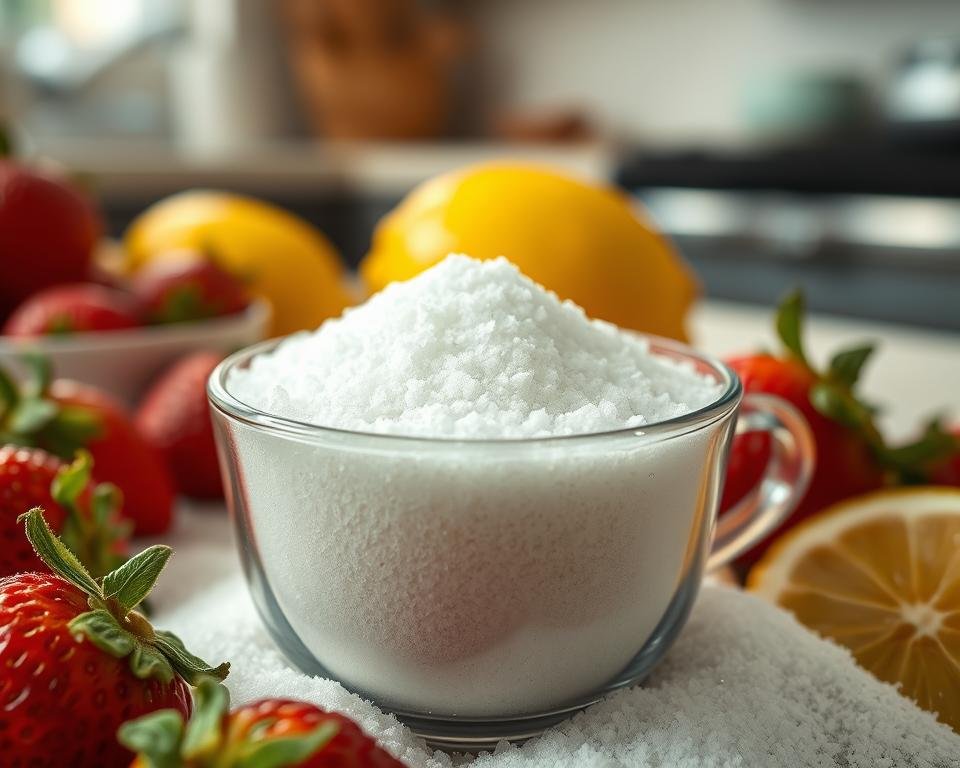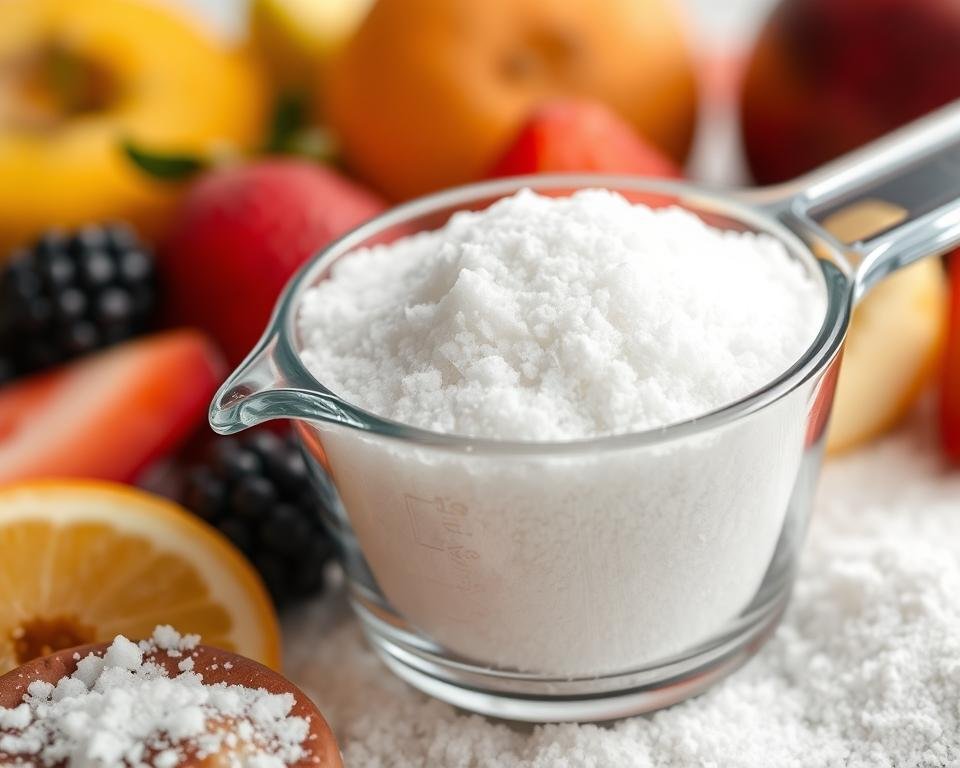Ever wondered how many calories are in a cup of sugar? A standard cup of granulated sugar, which is 200 grams, packs a lot of calories. It has a whopping 774 calories. This is because sugar is mostly carbs, with 199.6 grams out of 200 grams being pure sugar.
Sugar gives calories but no vitamins, minerals, or other good stuff. While it can give you quick energy, too much can cause problems. These include weight gain, type 2 diabetes, and heart disease. Knowing how many calories sugar has is key to controlling your sugar intake for better health.
Understanding Sugar Basics and Caloric Content
Sugar is everywhere in our food, from cakes to drinks. Knowing about sugar types, what it’s made of, and its calories is key for a healthy diet. Let’s explore the basics of sugar and how it affects our calorie intake.
Different Types of Sugar
Sugar has many forms, like table sugar, brown sugar, molasses, honey, and syrups. Each one has about 4 calories per gram. This makes sugar a big calorie source in our diets.
Why Calories Matter in Sugar
Sugar gives quick energy but has no vitamins or minerals. Eating too much sugar can cause weight gain and health problems. Knowing sugar’s calorie count is important for controlling calories and keeping a balanced diet.
Basic Sugar Composition
Different sugars have different makeup, with some having more fructose. For example, honey has about 46.5% fructose, while table sugar is mostly sucrose. These differences affect sugar’s calorie content and how it’s processed by our bodies.
“Consuming too much sugar, regardless of its source, can lead to weight gain and other health issues.”
How Many Calories in Cup of Sugar: Detailed Breakdown
A standard cup of granulated sugar (200g) has a lot of calories. It packs 774 calories. This means each teaspoon (4g) of sugar has about 15.4 calories.
Sugar is just energy from carbs, with no other nutrients. Also, how you measure sugar can change how many calories you get. For example, 1/2 cup of granulated sugar has 387 calories. And 1 teaspoon has 16 calories.
| Serving Size | Calories |
|---|---|
| 1/2 cup (100g) | 387 |
| 1 serving (1 cube) | 9 |
| 1 serving packet | 11 |
| 1 teaspoon (4g) | 16 |
| 100 grams | 387 |
| 1 cup (200g) | 774 |
Sugar’s calorie content is simple: 0% fat, 100% carbohydrates, 0% protein. It gives only energy from carbs, without any other nutrients.

“A cup of granulated sugar (200g) contains 774 calories, which is a significant amount of energy from a single ingredient.”
Knowing how many calories sugar has is key to managing calories. It helps make smart food choices. By watching sugar amounts and their calorie counts, you can control sugar intake and stay healthy.
Nutritional Profile of Granulated Sugar
Granulated sugar, also known as white sugar or table sugar, is a pure carbohydrate source. A cup of granulated sugar has 774 calories, with almost no other nutrients. It is 100% carbohydrates, 0% fat, and 0% protein.
Carbohydrate Content
Granulated sugar is almost all carbohydrates. A cup has 199.96 grams of total carbohydrates. This is 73% of the daily recommended value for carbs. But these carbs are simple sugars, lacking fiber, vitamins, and minerals.
Mineral Content
Granulated sugar has very little in essential minerals. A cup has only 2mg of calcium, 0.1mg of iron, and 4mg of potassium. This shows how bad it is to eat a lot of refined sugar.
Vitamin Content
Granulated sugar has no vitamins. A serving has 0mcg of Vitamin A, 0mg of Vitamin C, and 0mcg of Vitamin D. This makes sugar an empty calorie food, with no nutritional value.
In summary, granulated sugar is just carbs, with a high glycemic index of 65. It can quickly raise blood sugar levels. While it makes food taste better, it’s not good for a healthy diet.

Converting Sugar Measurements and Calories
Knowing how much sugar you eat is key to a healthy diet. One teaspoon of sugar has about 15.4 calories and 4g of carbs. A tablespoon of sugar, which is 12g, has around 46.2 calories and 12g of carbs.
Seeing sugar in teaspoons can help you control your sugar intake. For example, a sweet drink with 26 grams of sugar in an 8-ounce cup has 6 1/2 teaspoons. A 12-ounce serving with 39 grams of sugar has 10 teaspoons. And a 20-ounce serving with 65 grams of sugar has 16 1/4 teaspoons.
| Serving Size | Grams of Sugar | Teaspoons of Sugar | Calories |
|---|---|---|---|
| 8 oz | 26g | 6 1/2 | 100 |
| 12 oz | 39g | 10 | 150 |
| 20 oz | 65g | 16 1/4 | 250 |
Using the nutrition label and knowing sugar-to-calorie conversions helps you make better choices. It’s about being aware of sugar’s impact on your diet. This way, you can move towards a healthier, more balanced eating plan.
“Visualizing the impact of grams of sugar by converting them to teaspoons helps individuals make informed choices about their sugar consumption and caloric intake.”
Health Impact of Sugar Consumption
Too much sugar can harm our health, affecting blood sugar and weight. It’s important to know how sugar impacts our well-being.
Blood Sugar Effects
Sugar, like refined and added sugars, quickly raises blood glucose. This can cause prediabetes and type 2 diabetes. It also leads to insulin resistance, a sign of these conditions.
Weight Management Considerations
Sugar has empty calories and no nutritional value. Too much can cause weight gain and obesity. This increases the risk of heart disease and certain cancers. It’s key to eat balanced and watch sugar intake for weight management.
“The average American consumes about 17 teaspoons of added sugar per day, far exceeding the recommended limits.”
Health groups advise limiting added sugar to 6 teaspoons (25 grams) for women and 9 teaspoons (36 grams) for men daily. Being aware of sugar intake and choosing healthier options can protect our health.
Common Uses of Sugar in Cooking and Baking
Sugar is a key ingredient in cooking and baking. It’s not just for sweetness. It also improves the taste and texture of many dishes.
In cooking, sugar balances flavors. It can soften bitter or sour tastes, making food more enjoyable. Sugar also helps create the rich, caramel flavors we love.
In baking, sugar is essential. It adds structure and moisture to baked goods. Brown sugar makes them chewy, while powdered sugar makes them tender. Sugar also helps them brown and stay moist.
| Sugar Type | Culinary Uses |
|---|---|
| Granulated Sugar | The most common type of sugar used in baking, providing structure and sweetness. |
| Brown Sugar | Used in dense baked goods like zucchini bread, rich cookies, and glazes, contributing chewiness and unique flavor. |
| Powdered Sugar | Dissolves quickly, creating tender treats, and is often used in frostings and confections. |
| Superfine Sugar | Commonly used in the UK for baking, as it dissolves easily and provides a fine texture. |
While sugar is great in cooking and baking, we should use it wisely. The Dietary Guidelines suggest we limit added sugars to 10% of our daily calories. This helps avoid health issues like obesity and diabetes.
In conclusion, sugar is incredibly versatile in the kitchen. It enhances flavors, textures, and reactions. By knowing how to use different sugars, we can create amazing dishes.
Sugar Alternatives and Their Caloric Values
More people want to eat less sugar, leading to a big increase in sugar substitutes. These come in natural and artificial types, each with different calories and sweetness. Knowing the differences helps you choose what’s best for you.
Natural Sweeteners
Natural sweeteners like honey, agave nectar, and maple syrup are seen as healthier than regular sugar. But, they do have calories and carbs. For instance, a tablespoon of honey has about 64 calories and 17 grams of carbs. Maple syrup has around 52 calories and 13 grams of carbs per tablespoon.
Artificial Sweeteners
Artificial sweeteners like aspartame, sucralose, and saccharin are sweet but have almost no calories. Aspartame is 200 times sweeter than sugar and has 4 calories per gram. Sucralose is 600 times sweeter and has 0 calories. Saccharin, discovered in 1879, is 200 to 700 times sweeter and has fewer than 4 calories per gram.
Sugar alcohols, like xylitol and sorbitol, have fewer calories than sugar. They are 50% to 90% as sweet as sugar but eating too much can cause bloating and diarrhea.
Choosing a sugar substitute depends on what you like, your diet, and your health goals. Whether you prefer natural or artificial sweeteners, always check the nutrition labels. This way, you know the calories and nutrients in what you’re eating.
Storage and Shelf Life of Sugar
Keeping sugar fresh is important. Store granulated sugar in an airtight container in a cool, dry place. This keeps it away from heat and light. If stored right, sugar can last up to 30 years.
But, it’s best to use opened sugar within two years. This way, it stays fresh and tastes better.
Sugar doesn’t usually go bad. But, it can pick up moisture and smells if not stored well. Don’t put sugar in the fridge. The moisture can make it clump or harden.
For long storage, use airtight jars or food-grade buckets. This helps keep it clean and fresh.
Other sweeteners like honey and artificial sugars also last a long time. Honey can last forever in a sealed container. Processed stevia and some artificial sweeteners also have a long shelf life.
Knowing how to store your sugar and sweeteners right keeps them fresh. This makes them ready for all your cooking and baking.
FAQ
How many calories are in a cup of granulated sugar?
A cup of granulated sugar (200g) has 774 calories.
How many calories are in a teaspoon of sugar?
One teaspoon of sugar (4g) has about 15.4 calories.
How many carbs are in a teaspoon of sugar?
A teaspoon of sugar (4g) has 4g of carbs.
How many calories are in a tablespoon of sugar?
A tablespoon of sugar (12g) has about 46.2 calories.
What is the composition of granulated sugar?
Granulated sugar is mostly carbohydrate. It has 4g of sugar per teaspoon. It also has small amounts of calcium, iron, and potassium per cup.
Does sugar have any vitamins or fiber?
No, sugar has no vitamins, fiber, or protein. It gives energy but lacks other nutrients.
How does the glycemic index of sugar affect blood sugar levels?
Sugar’s glycemic index is 65, which means it quickly raises blood sugar. Eating too much sugar can cause health problems like obesity and diabetes.
What are some common uses of sugar in cooking and baking?
Sugar is used in cooking and baking for flavor and texture. It helps preserve food and aids in fermentation.
What are some sugar alternatives and how do they compare in calories?
Honey and agave nectar have calories similar to sugar. Artificial sweeteners like aspartame have little to no calories. Sugar alcohols like xylitol have fewer calories but can upset your stomach if eaten too much.
How should sugar be stored and what is its shelf life?
Store sugar in an airtight container, away from heat and light. It lasts 18 to 24 months. Sugar doesn’t spoil but can pick up odors, so don’t freeze it.



